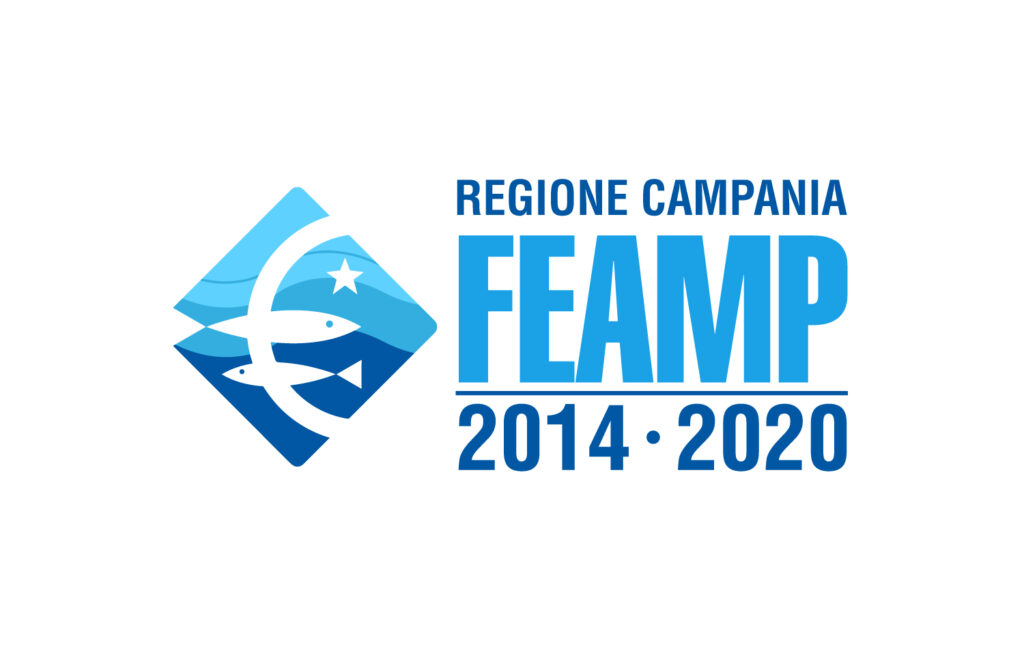Research
Innovative food preservation technologies: static and pulsed electric fields
by Nunzio Velleca – research fellow
In recent years, innovative technologies based on the use of static electric fields and pulsed electric fields have attracted considerable interest in the food sector.
Pulsed electric fields consist of the application of high voltage, short duration electrical pulses (Barba et al., 2015), which if applied at certain levels to biological tissues, cause cellular permeabilization or electroporation, i.e. opening of pores in correspondence with the cellular membranes which, in a simplified way, can be reversible or irreversible (Velickova et al., 2018) . Reversible electroporation determines a temporary opening of the pores which can be exploited to insert substances of interest into the cells, while irreversible electroporation causes permanent damage to the cell membranes and is usually used in microbial inactivation processes (Lopez-Alonso et al., 2019) and is therefore applied for pasteurization processes in the food sector.
Static waves are a type of electromagnetic radiation generated by an electric field constant over time and are generally generated at low voltage. Using static waves it is possible to store fresh food at temperatures lower than 0°C without causing the water to freeze. This effect results in an extension of the shelf-life of the relevant product without incurring phenomena of compromise of sensorial quality caused by freezing. In fact, it has been demonstrated that the application of static waves preserves the color and flavor of foods, without damaging the cell walls (Yang et al., 2023).
At the CAISIAL University Center of the University of Naples Federico II, as part of the project “Enhancement of fish products from Campania, static electric field technology was applied for the refrigerated conservation of some foods including white prawns (Parapenaeus longirostris), anchovies (Engraulis encrasicolus) and the lupine clam (Chamelea gallina). In white prawns, after four days of storage at +4°C (Fig.1), this technology was found to be effective in reducing the phenomenon of melanosis, i.e. the blackening of the prawn carapace.
In the conservation of the lupine clam, the static waves have shown a protective effect from the loss of intervalve water of the molluscs during refrigerated conservation which on the one hand prolongs the life time of the product and on the other reduces the economic loss due to the weight loss of the product. In Mediterranean anchovies preserved in ice, however, the effects of static waves were less marked and appreciable only for prolonged storage times. Further experiments are underway to evaluate the effects of static waves in storage at temperatures below 0°C where such effects could be further improved.
The application of these technologies, alone or in combination with others, can improve the quality and prolong the shelf-life of fish products, consequently contributing to the increase in market value and the reduction of food waste.
| STATIC WAVES |
| CHECK |
Figure 1 – White prawns preserved for four days with and without static wave technology at 4°C
BIBLIOGRAPHY
- Barba, F. J., Parniakov, O., Pereira, S. A., Wiktor, A., Grimi, N., Boussetta, N., … & Vorobiev, E. (2015). Current applications and new opportunities for the use of pulsed electric fields in food science and industry. Food research international, 77, 773-798.
- López-Alonso, B., Hernáez, A., Sarnago, H., Naval, A., Güemes, A., Junquera, C., … & Lucía, O. (2019). Histopathological and ultrastructural changes after electroporation in pig liver using parallel-plate electrodes and high-performance generator. Scientific Reports, 9(1), 2647.
- Yang, N., Zhang, X., Lu, Y., Jiang, F., Yu, J., Sun, X., & Hao, Y. (2023). Use of DENBA+ to assist refrigeration and extend the shelf-life of strawberry fruit. Postharvest Biology and Technology, 195, 112152.
- Velickova, E., Tylewicz, U., Dalla Rosa, M., Winkelhausen, E., Kuzmanova, S., & Romani, S. (2018). Effect of pulsed electric field coupled with vacuum infusion on quality parameters of frozen/thawed strawberries. Journal of Food Engineering, 233, 57-64.
Impact of ozone on the shelf-life of fish
Anna Ilaria Di Paola – research grant holder
Anna Ilaria Di Paola – boraFish products are highly perishable foods, in fact in the absence of correct conservation, microbial, enzymatic and chemical processes are rapidly established which lead to the loss of freshness and reduction of shelf-life (Ghaly et al., 2010) .research system A short shelf life represents a limiting factor for consumers’ growing demand for fresh fish. For this reason, the need to resort to innovative technologies that can extend the shelf-life of the fish is increasingly felt. Several studies have shown that ozone treatment is one of the most promising non-thermal technologies for the seafood industry (Gonçalves, 2009).
Ozone (O3) is an allotropic form of oxygen (O2), meaning it is composed of the same atoms, but combined in a different form. The production of ozone from oxygen occurs through the generation of high voltage electrical discharges, which cause the splitting of oxygen into atoms which in turn bind to other oxygen molecules, thus forming the ozone molecule (Kogelschatz et al., 1988; Guzel-Seydim et al., 2004 Duguet, 2004).
Ozone, thanks to its potential oxidizing capacity, is a powerful broad-spectrum antimicrobial capable of acting on bacteria, viruses and fungi (Kim, 1999). Furthermore, its ability to act on off-flavours is significant and despite being an oxidising agent, some authors have demonstrated a delay in the development of secondary lipid oxidation indices in fish products (Okpala, 2016; Aponte et al., 2018 ). Another advantage of ozone is its instability, in fact, after carrying out its action it reconverts into molecular oxygen without leaving harmful residues in the environment. For this characteristic, the application of ozone is considered a green technology biocompatible with the environment.
However, excessive use of ozone has negative effects on phospholipids, polyunsaturated fatty acids (PUFA) and membrane proteins (Gonçalves, 2009), irreversibly modifying the structural and functional properties, and can also induce whitening and the development of unwanted odors (Kim, 1999).
In 1997 ozone received the GRAS (Generally Recognized as Safe) classification and in 2001 the FDA recognized ozone as an “antimicrobial agent for the treatment, storage and processing of foods” (Gonçalves, 2009). EFSA (2014) recommends its use for the disinfection of leafy vegetables and red fruits to reduce the risk of transmission of some pathogens.
In the fishing industry, ozone is very widespread as a disinfection system in water treatment plants for the purification of bivalve molluscs. There are several studies that have evaluated the effect of ozone on fish, applying it with different technologies: nebulization of ozonated water (Crowe et al., 2012), ozone baths (Kötters et al., 1997, Jhunkeaw et al., 2021), ozone in cold storage (Cortesi et al., 2011) and ozonated slurry ice, a biphasic system composed of ice crystals dispersed in chilled seawater, combined with ozone (Campos et al., 2005).
Currently some techniques, such as nebulization of ozonated water and ozone baths, are applied in the fishing supply chain, in order to extend the shelf-life.
BIBLIOGRAPHY
- Ghaly, A E, Dave D, Budge S, & Brooks MS (2010). Fish spoilage mechanisms and preservation techniques. American Journal of Applied Sciences, 7(7), 859.
- Manousaridis, G., Nerantzaki, A., Paleologos, E. K., Tsiotsias, A., Savvaidis, I. N., & Kontominas, M. G. (2005). Effect of ozone on microbial, chemical and sensory attributes of shucked mussels. Food Microbiology, 22(1), 1-9.
- Guzel-Seydim, Z. B., Greene, A. K., & Seydim, A. C. (2004). Use of ozone in the food industry. LWT-Food Science and Technology, 37(4), 453-460.
- Kogelschatz, U., Eliasson, B., & Hirth, M. (1988). Ozone generation from oxygen and air: discharge physics and reaction mechanisms. The Journal of the International Ozone Association
- Duguet, J. P. (2004), Basic concepts of industrial engineering for the design of new ozonation processes. Ozone News, 32 (6), 15-19.
- Kim, J. G., Yousef, A. E., & Dave, S. (1999). Application of ozone for enhancing the microbiological safety and quality of foods: a review. Journal of Food Protection, 62(9), 1071-1087.
- Gonçalves, A. A. (2009). Ozone: an emerging technology for the seafood industry. Brazilian archives of Biology and Technology, 52, 1527-1539.
- Scientific Opinion on the Risk Posed by Pathogens in Food of Non-Animal Origin. Part 2 (Salmonella and Norovirus in Leafy Greens Eaten Raw as Salads). EFSA J. 2014, 12, 3600.
- Okpala, C. O. R. (2016). Lipid autoxidation in ozone‐processed crustacea under cold storage: A treatise. Lipid Technology, 28(5-6), 93-95.
- Aponte, M., Anastasio, A., Marrone, R., Mercogliano, R., Peruzy, M. F., & Murru, N. (2018). Impact of gaseous ozone coupled to passive refrigeration system to maximize shelf-life and quality of four different fresh fish products. LWT, 93, 412-419.
- Crowe, K. M., Skonberg, D., Bushway, A., & Baxter, S. (2012). Application of ozone sprays as a strategy to improve the microbial safety and quality of salmon fillets. Food Control, 25(2), 464-468.
- Kötters, J., Prahst, A., Skura, B., Rosenthal, H., Black, E. A., & Rodigues‐Lopez, J. (1997). Observations and experiments on extending shelf‐life of ‘rockfish’ (Sebastes spp.) products with ozone. Journal of Applied Ichthyology, 13(1), 1-8.
- Cortesi, M. L., Sarno, E., Costanzo, N., Ferrante, S., & Santoro, A. (2011). Ozone decontamination of chilled poultry carcasses. Italian Journal of Food Safety, 1(1), 51-54.
- Jhunkeaw, C., Khongcharoen, N., Rungrueng, N., Sangpo, P., Panphut, W., Thapinta, A., … & Dong, H. T. (2021). Ozone nanobubble treatment in freshwater effectively reduced pathogenic fish bacteria and is safe for Nile tilapia (Oreochromis niloticus). Aquaculture, 534, 736286.
- Campos, C. A., Rodríguez, Ó., Losada, V., Aubourg, S. P., & Barros-Velázquez, J. (2005). Effects of storage in ozonised slurry ice on the sensory and microbial quality of sardine (Sardina pilchardus). International journal of food microbiology, 103(2), 121-130.
SENSORY ANALYSIS FOR THE ASSESSMENT OF THE FRESHNESS OF FISH PRODUCTS
Lucia Avella – Research fellow
In the food sector, obtaining high quality standards represents one of the main objectives of every production chain. As far as fish products are concerned, this objective is closely related to the freshness of the raw material. In fact, fresh fish products are subject to rapid perishability which it alters the microbiological, chemical, physical and sensorial properties (Masullo etal., 2015).
Freshness assessment can be performed using sensory, physical, chemical and microbiological methods. These methods represent an evolution of the fish inspections, carried out by law by Health Service Veterinarians in markets and retail. Among these, the sensorial method is undoubtedly the quickest and easiest to apply, although it has the limitation of being subjective in the expression of the results, if the judges who carry out the analysis are not properly recruited and trained (Arcangeli et al., 2003). To determine the freshness of the catch there are various sensory methods: the Artioli-Ciani scheme, the Torry method, the EAB scheme and the Quality Index Method (QIM). The Artioli-Ciani scheme was developed in Italy and is still used by commercial operators in the sector. This involves dividing the product into four categories: very fresh, fresh, stale and altered. The evaluation is based on the characteristics detectable on sensorial examination, of which cadaveric rigidity and odor as fundamental characteristics and general appearance, consistency, eye and gills as auxiliary characteristics. The Torry scheme is mainly applied to cooked products and involves the use of a 10-point demerit scale, where the highest score corresponds to fresh fish, while the score is reduced with the loss of freshness. The fish is considered acceptable only if it obtains a score of no less than 6 while scores lower than 3 indicate a definitively deteriorated product (Alasalvar et al., 2001). The only quality classification system that has legal status in Europe is the EAB method. The CE 2406/96 reg. establishes common rules for the marketing of 39 species of sea fish (white fish, blue fish, selacians); 4 of shellfish; 2 of cephalopods. This scheme, used for assessing the quality of raw fish in industry and veterinary inspection services, establishes three degrees of freshness: E, A and B, corresponding to various stages of deterioration. E (Extra) is the highest possible quality, while fish with a score lower than B is considered unfit for human consumption. In order to evaluate freshness with an internationally recognized method, the Tasmanian Food Research Unit, has developed a sensory method called Quality Index Method (QIM) (Bremner, 1985), which must be detailed for each fish species. The QIM is based on the objective evaluation, by trained judges, of some sensory parameters of raw fish (skin, eyes, gills, etc.) which change significantly during the process of quality decay, dividing them into olfactory, visual and texture parameters . The method is quantitative and involves, for each attribute, the use of three-point demerit scales (table 1). The demerit scores assigned to each attribute are added to obtain a total sensory score, called Quality Index (QI), which indicates the overall freshness of the product. In this way, the closer the IQ is to zero, the fresher the fish (Figure 1); the more it increases, the less fresh it is (figure 2e3) (Bonilla et al., 2007; Hyldig & Green-Petersen, 2005; Martinsdóttir et al., 2001; Sveinsdóttir et al., 2003).
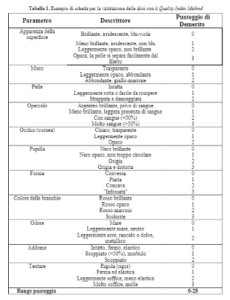
In conclusion, the QIM for freshness assessment is an effective method due to its speed, it is non-destructive, requires a short training period compared to other methods and provides an adequate estimate of freshness assessment in the fishery product supply chain (Lougovois et al., 2003). Naturally, to obtain more accurate results on the freshness of the catch it is advisable to combine chemical, physical and microbiological analyzes with sensory evaluation.
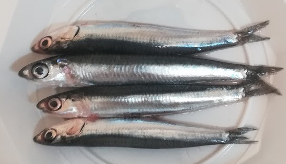
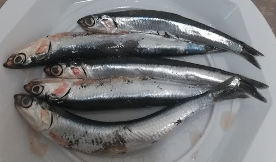
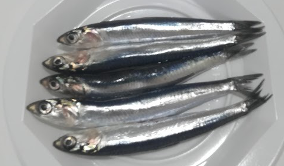
Figure 1. Anchovies stored at +4°C from left to right at fishing, after 1 and 7 days, respective QIM values equal to 0, 6 and 17.
BIBLIOGRAPHY
- Alasalvar, C., Taylor, K. D. A., Öksüz, A., Garthwaite, T., Alexis, M. N., & Grigorakis, K. (2001). Freshness assessment of cultured sea bream (Sparus aurata) by chemical, physical and sensory methods. Food chemistry, 72(1), 33-40.
- Arcangeli, G., Baldrati, G., & Pirazzoli, P. (2003). La trasformazione dei prodotti della pesca: tecnologia, controllo e igiene di lavorazione. SSICA Stazione sperimentale per l’industria delle conserve alimentari.
- Bonilla, A. C., Sveinsdottir, K., & Martinsdottir, E. (2007). Development of Quality Index Method (QIM) scheme for fresh cod (Gadus morhua) fillets and application in shelf life study. Food control, 18(4), 352-358.
- Bremner, H. A. (1985). A convenient, easy to use system for estimating the quality of chilled seafoods. Fish Processing Bulletin, 7, 59-70.
- Hyldig, G., & Green-Petersen, D. M. (2005). Quality Index Method—an objective tool for determination of sensory quality. Journal of aquatic food product technology, 13(4), 71-80.
- Lougovois, V. P., Kyranas, E. R., & Kyrana, V. R. (2003). Comparison of selected methods of assessing freshness quality and remaining storage life of iced gilthead sea bream (Sparus aurata). Food Research International, 36(6), 551-560.
- Martinsdóttir, E., Sveinsdottir, K., Luten, J., Schelvis-Smit, R., & Hyldig, G. (2001). Reference manual for the fish sector: sensory evaluation of fish freshness.
- Masullo, T., Bennici, C., Salamone, M., Tagliavia, M., Nicosia, A., Mazzola, S., & Cuttitta, A. (2015). Analisi dei profili nutrizionali e valutazione degli indicatori di performance inerenti la shelf life di prodotti ittici.
- Sveinsdottir, K., Hyldig, G., Martinsdottir, E., Jørgensen, B., & Kristbergsson, K. (2003). Quality Index Method (QIM) scheme developed for farmed Atlantic salmon (Salmo salar). Food Quality and Preference, 14(3), 237-245.
WORKSHOP “Enhancement of Campania fishing products” – PRESS RELEASE
October 27, 2023
Yesterday morning, in the splendid setting of the Chinese room at the Reggia di Portici, the workshop entitled “Enhancement of Campania fishing products” was held, promoted by the University Center for Innovation and Development of the University’s Food Industry of the studies of Naples Federico II with the participation of the Department of Agriculture and the Experimental Zooprophylactic Institute of Southern Italy.
The course was created as part of the dissemination initiatives and for the presentation of the results of the project of the same name financed by the Campania Region, drawing on EMFF 2014/2020 Mis funds. 1.26 “innovation”. The event, developed in two distinct sessions, had as its key theme the evaluation of the quality of fresh fish products in the particular context of Campania fishing for better valorisation of the supply chain.
During the first session of the workshop, numerous speakers from different disciplines gave their contribution in relation to the biochemistry and microbiology of fresh product degradation, legislative aspects and the role of food technologies in improving refrigerated storage time and sensory analyses. on the catch.
The work was opened by prof. Paolo Masi, scientific manager of the project and Director of the CAISIAL Centre, who illustrated the objectives of the project, also focusing attention on the potential of modern food technologies for a relaunch of the sector in the Campania region.
Dr. Federico Capuano, Director of the Food Inspection Department at IZSM in Portici, illustrated the institute’s activities in relation to the safety of Campania fish products and Dr. Fabio Di Nocera, head of the Ichthyopathology unit, showed the results of a study conducted by the IZSM on the microbial degradation shelf-life of trawling products.
The professors Prospero di Pierro and Silvana Cavella respectively reported on the biochemical and physical techniques to evaluate the state of degradation of fish products. The professors Elena Torrieri and Rossella Di Monaco showed the role of innovative shelf-life extension technologies and sensory sciences respectively and prof. Francesco Aversano spoke on the topic of Food Law.
In the second session of the workshop, young researchers from the University’s CAISIAL Center presented the results of their scientific activities. In particular, Dr. Giovanni Fiorile showed how the use of static waves can help in extending the shelf-life of fresh refrigerated anchovies while Dr. Giacomo Castiello showed results of refrigerated vital conservation experiments of the lupine clam under vacuum conditions and using static electric fields. Dr. Nunzio Velleca has instead studied various technologies applicable in the prevention of melanosis (blackening of the carapace) of shrimp such as active edible coatings, ozone and static electric fields while Dr. Davide Bevilacqua gave a report on the potential of a spectroscopic evaluation technique (FT-NIR) for evaluating the freshness of bluefin tuna fillets.
Finally, Dr. Antonio Luca Langellotti presented a preview of a manual on the quality of fresh fish products from Campania intended for supply chain operators.
The event was an effective moment of discussion and in-depth analysis of the problems of the fresh fish supply chain in Campania and provided numerous stimuli for the contribution that research and technological transfer can have on practice.
03/10/2023
Ice in the conservation and transport of fresh fish products
by A. Luca Langellotti
The continuous cooling of fish products starting from the moments after fishing until reaching the final consumer is a fundamental issue for the fishing industry to guarantee safe and high quality products. Cold is able to increase shelf-life by lowering the speed of degrading chemical reactions and slowing down the activity of both pathogenic and degrading microorganisms and enzymes.
The organoleptic quality of fresh refrigerated fish products is highly appreciated by consumers who prefer them over frozen and processed products for medium and long shelf life.
Historically, the advent of ice in the fishing sector has also allowed populations far from the coasts to benefit from the consumption of fresh fish products while previously they had to settle for dried or salted products. The ice allows the fish to cool quickly, remain at temperatures very close to zero and also avoid dehydration of the surface.
The conservation of marine fish from temperate waters in ice can have a limit duration of over twenty days (more commonly up to ten), although this is very variable depending on the species, the temperature of the fishing waters, the fishing method, the refrigeration speed, any evisceration and the season[i].
In the retail market and with the final consumer, it is very difficult to maintain temperatures close to zero but generally temperatures between +2 and +5°C are used, which lead to a very short shelf-life compared to products stored at temperatures close to 0° C.
On fishing boats it is necessary to proceed quickly with cooling the catch. A rule of thumb states very roughly that every hour that fresh fish is not cooled immediately after capture, especially on hot days, results in an entire day’s loss of shelf life.
There are a wide range of machines for producing different types of ice for different applications. In addition to standardized systems for “normal” fields of application, many manufacturers offer customized solutions that are adapted to the specific needs and requirements needed for certain types of fisheries and modes of transport and distribution. Modern ice making machines should not only have a high production capacity, but also be reliable, robust and low-maintenance, as well as being cost-effective and energy-efficient, since the cooling energy stored in the ice must first be spent during the production process. The type of ice most used in Italian fishing is crushed ice, made up of small grains of ice that adapt to the shapes of the fish. Less common is the use instead of flaked ice and blocks of ice sometimes used for baying tanks, a traditional method of refrigeration in which freshly caught fish is immersed in a balanced mixture of sea water and ice generally with a volume ratio between 2:1 and 1:1. With this method, the catch retains unaltered livery characteristics such as pigmentation and brilliance for longer times than simply covering it with ice.
In recent years, a very efficient type of creamy ice or liquid ice (slurry ice) obtained using different technologies based on the use of sea water has also been spreading. This ice is composed of microscopic crystals capable of surrounding the entire body of fishing products, cooling them quickly and uniformly. Furthermore, it is easily transportable, it can be pumped through pipes and then transported from the ice machine to the place of use, making operations on board less tiring. It has no sharp edges so the catch does not suffer superficial mechanical damage.
It has no sharp edges so the catch does not suffer superficial mechanical damage.[ii] or antioxidant agents that further improve shelf-life. Recent studies have shown that during the processing phases of sea bream (Sparus aurata), ice cream increased the bacteriological and organoleptic shelf-life of the product at different times of the year to between 2 and 7 days.[iii].
An interesting European project (ICE2LAST) has made it possible to develop two types of liquid ice with microencapsulated essential oils capable of improving the shelf-life of the product and also an anesthetizing ice with clove oil useful for reducing the suffering of live fish raised immersed on ice for cullinga, [iv].
The use of liquid ice using salt water (or sea water) or baying in a 1:1 ratio of sea water and ice is able to maintain the products at a temperature around -2 °C (just above the freezing). This technique called “super-chilling” allows you to significantly increase shelf life. Experiments on cod fillets have shown that super-chilling at –1.7 °C leads to a sensorial acceptability extended up to 32 days without any difference between exposure of the product in air or in a modified atmosphere at 35% CO2. However, the coupling of the two technologies has the advantage of also inhibiting microbial growth and the formation of volatile basic amines[v].
Numerous studies also show that transport at dry super-chilling temperatures is also more sustainable than conventional ice cooling, especially due to the reduction in the amount of expanded polystyrene and the reduction in the weight and volume of ice which impacts fuel consumption. for transportation.
The water used for the production of ice must comply with the drinkability or cleanliness requirements established by Regulations no. 852/2004 (annex I) and 853/2004, as indicated in the ministerial guidelines. When it comes to using clean seawater on board fishing vessels, it is essential to source it from areas far from sources of pollution. It is absolutely forbidden to use water coming from the port or from areas that are too superficial. The latter are particularly at risk due to the presence of pollutants such as hydrocarbons and microbial contaminants.
Rarely used in the refrigeration of fish, dry ice (solid carbon dioxide) is very suitable for international shipments at very low temperatures. The advantage is that it does not cause percolation (direct sublimation of CO2), requires very low quantities to maintain the temperature (weight reduction in transport) and CO2 has an inhibitory effect on bacterial growth. However, given its very low temperature, dry ice cannot be put in direct contact with fishing products which could be irremediably damaged.
In conclusion, ice is still the cooling medium of choice today, both in small-scale coastal fishing and in industrial fishing, capable of guaranteeing the maintenance of organoleptic quality and food safety from sea to table.
The development of modern ice cooling technologies is necessary today to better respond to the needs of increasingly demanding consumers in terms of the quality of fresh products and to contribute to sustainability by reducing the waste of spoiled products and improving economic and environmental sustainability.
Bibliography
[i] Tavares, J., Martins, A., Fidalgo, L. G., Lima, V., Amaral, R. A., Pinto, C. A., … & Saraiva, J. A. (2021). Fresh fish degradation and advances in preservation using physical emerging technologies. Foods, 10(4), 780.
[ii] Campos, C. A., Rodríguez, Ó., Losada, V., Aubourg, S. P., & Barros-Velázquez, J. (2005). Effects of storage in ozonised slurry ice on the sensory and microbial quality of sardine (Sardina pilchardus). International journal of food microbiology, 103(2), 121-130.
[iii] Ntzimani, A., Angelakopoulos, R., Stavropoulou, N., Semenoglou, I., Dermesonlouoglou, E., Tsironi, T., … & Taoukis, P. (2022). Seasonal pattern of the effect of slurry ice during catching and transportation on quality and shelf life of gilthead sea bream. Journal of Marine Science and Engineering, 10(3), 443.
[iv] Innovative stunning technology based on a natural anesthetizing agent in ice to improve animal welfare and extend shelf-life of farmed fish. ICE2LAST. H2020 ID 736169, https://cordis.europa.eu/project/id/736169
[v] Sørensen, J. S., Bøknæs, N., Mejlholm, O., & Dalgaard, P. (2020). Superchilling in combination with modified atmosphere packaging resulted in long shelf-life and limited microbial growth in Atlantic cod (Gadus morhua L.) from capture-based-aquaculture in Greenland. Food microbiology, 88, 103405.

